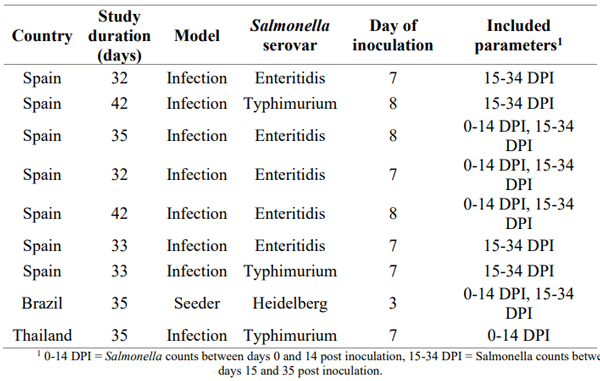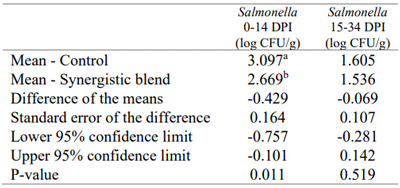I. Introduction
Salmonella spp. in poultry pose a serious risk for food safety. The complex nature of Salmonella infections in poultry requires a multifactorial solution. It is key to preventing Salmonella colonization throughout the entire gastrointestinal tract (GIT). Short chain fatty acids (SCFA) have been described as having beneficial effects in the upper part of the gut, whereas medium chain fatty acids (MCFA) target the lower GIT (Van Immerseel et al., 2009). Coated butyrate is described as having an effect in the lower GIT (Van Immerseel et al., 2005). Combining these three ingredients into one feed additive blend results in a targeted response to Salmonella throughout the GIT. In addition, since a microbial imbalance, due to overgrowth by organisms such as Salmonella, may cause a less efficient gut immune response, a fourth ingredient was considered. Hydrolyzed copra meal with ß-1,4 mannobiose as main ingredient has proven beneficial effects against Salmonella in vitro and in vivo in broiler chickens, in addition to activating the innate immune response in macrophages, supporting the natural host defense mechanisms (Agunos et al., 2007; Ibuki et al., 2011). It is hypothesized that feeding a synergistic blend containing SCFA, MCFA, hydrolyzed copra meal (containing ß-1,4 mannobiose) and microencapsulated sodium salts of butyric acid will reduce Salmonella colonization in the GIT of broiler chickens. Several studies have been performed around the globe to show effects of this synergistic blend; however due to differences in study design and geographic differences the results were not always consistent. Therefore, all these studies were combined into one meta-analysis, aimed at investigating the overall effect of the synergistic blend on Salmonella colonization in Salmonella challenged broiler chickens, regardless of experimental conditions.
II. Materials and methods
Thirteen studies, conducted at various research institutes around the globe (Brazil, Spain, Thailand) were included in the meta-analysis. All included studies were performed at Trouw Nutrition research facilities or done at research institutes in collaboration with Trouw Nutrition. None of the studies were published, details on the study design per study are shown in Table 1. All studies were done in broiler chickens that were challenged with one of the Salmonella strains (Enteritidis, Typhimurium, or Heidelberg). In each study, from day 1 onwards, the birds received either a control diet, or the control diet with the synergistic blend (Fysal Fit-4, Trouw Nutrition, the Netherlands) added to it. The synergistic blend was a proprietary mixture of short chain fatty acids, medium chain fatty acids, hydrolyzed copra meal (containing 13% ß-1,4 mannobiose) and microencapsulated sodium salts of butyric acid. The blend was dosed at 3 kg/metric tonne in the first feeding phase, which varies in length up to maximum 23 days of the study, and 1 kg/metric tonne until the end of each study. In all 9 studies, quantitative Salmonella counts were enumerated in the caecum at one or more different days varying per study. Caecal Salmonella counts are expressed as log colony forming units (CFU) per gram caecal content.
The raw data containing caecal Salmonella counts of the studies were combined into one file. The data were analyzed in SAS using a mixed model including within and between study variation in the random and repeated statements. Data analysis was split into two statistical analyses. One contains the data between 0 and 14 days post inoculation (DPI), for which analysis 5 studies were included. The second contains data between 15 and 34 DPI, for which 8 studies were included.
Table 1 - Overview of studies included in the meta-analysis.
III. Results
The results of the meta-analysis are shown in Table 2. In the analysis for 0-14 DPI including 5 studies, the caecal Salmonella counts were significantly lower in the birds fed the synergistic blend compared to the control group. In total a reduction of 0.429 log CFU/g (+/- 0.164) was observed (P = 0.011). There were no significant differences between the control and the synergistic blend in Salmonella counts between 15-34 DPI including 8 studies (P = 0.519).
Table 2 - Overview of the meta-analysis results for Salmonella counts. Results of 0-14 DPI were based on 5 studies, results of 15-34 DPI were based on 8 studies.
IV. Discussion
The synergistic blend contains several ingredients and, based on the current data, it is not possible to link the results to any one of the ingredients. As described above, the main ingredients SCFA, MCFA, ß-1,4 mannobiose and the butyric acids are all individually described to have beneficial effects in Salmonella challenged chickens (Agunos et al., 2007; Ibuki et al., 2011; Van Immerseel et al., 2005; 2009). The combination of the different ingredients likely results in a functional feed additive that also supports the bird’s gut and supports the natural host defense mechanisms via the immune system. This is the first detailed study showing the effect of the synergistic blend on Salmonella control and growth performance, while combining different studies performed under various conditions. Future studies should be performed to look at other effects such as stimulation of the immune system or effect on gut health of the synergistic blend in addition to Salmonella reduction.
The inoculation of the birds included in the current study was done between day 3 and 8 of age, meaning young chicks were used for all studies. In young chicks, the gastrointestinal tract is not yet fully developed meaning that Salmonella can infect relatively easily. However, upon maturation of the gastrointestinal tract, Salmonella infections will be naturally reduced (Stern, 2008). This explains why there was no difference in Salmonella counts between 15-34 DPI.
From this study, it can be concluded that feeding a synergistic blend containing SCFA, MCFA, hydrolyzed copra meal (containing ß-1,4 mannobiose) and microencapsulated sodium salts of butyric acids may significantly reduce caecal Salmonella counts in young chicks within the first 14 DPI.
Presented at the 33th Annual Australian Poultry Science Symposium 2022. For information on the next edition, click here. 













.jpg&w=3840&q=75)